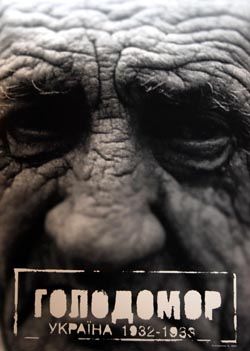HLDMR
Young artists from Kharkiv offer their interpretation of history Just before Nov. 7, 2008, the Academy of Arts hosted the poster exhibition “Ukraine. 1932-1933. Holodomor.”
The foreword to the catalogue of posters titled “Ukraine. 1932-1933. Holodomor” begins with the following message: “HLDMR... There are no vowels in this word. Try to pronounce it, and you will hear a set of muffled sounds, as if you had your mouth gagged. We seem to have lived all our lifetime like this - with gagged mouths. There were no vowel sounds. And the indistinct noises that came from the outside with reference to the famine of the 1930s failed to arouse our conscience. Some people died but, oh well, such was the time and it all happened so long ago. However, it turns out that these people were not just somebody out there but your own close relatives. Ten million Ukrainians! In two years... And not so long ago (75 years is not a long time).” The authors are members of the Kharkiv-based All-Ukrainian Association of Graphic Designers “4 Block” whose exhibit opened last Thursday at the Academy of Arts under the same name.
In the center of the exposition are two works with a red and a red-blue ribbon hanging down on the sides as symbols of the flags of the USSR and Soviet Ukraine. One bears the inscription “10 million” against a deathly black backdrop. The other poster has nothing else but crosses [above the graves of] those who died an innocent death and our [own graves]. Candles are flickering beneath the posters. This is a stunning spectacle that moves you to the depths of your heart, fills your eyes with tears, and leaves you speechless.
On both sides are posters with increasingly more vivid images. For example, there is one in which a thorny crown replaces the traditional floral wreath that girls wear. And here is another one with a ripe grain ear in barbed wire and a blurred top of the tree of life. Still another poster shows some soil on a platter with a spoon beside it. One poster involves an ornamental pattern that is similar to Ukrainian national motifs in 1932-1933 but consists of crosses.
There are also some very informative works. For instance, one poster conveys the message that [during the Holodomor] 17 Ukrainians died every minute, 1,000 every hour, and nearly 52,000 a day.
Another one quotes a security service archival document: “They are dying on the streets. They are being buried right there, five bodies in one grave, without a priest. Up to 20 die in a day, and people are eating people.” There is an enormous amount of pain and sorrow compressed in these fifty or so works.
“The participants, over 40 Kharkiv-based and mostly young authors, staged this exhibit ‘for themselves,’ i.e., in order to cause themselves to reflect [on the Holodomor],” says Oleh Veklenko, the curator of the exhibit. “It seemed to me it will be difficult to get present-day young designers interested in this theme. [I thought] they would say it was just a flash in the pan. But the result is different-it is really touching. These things remain in the genes of the next one or two generations. We are regaining memory through a tightlipped mouth and knocked-out vowels.”
“Those who died evidently do not need this knowledge,” says Vitalii Shustia, the chief of the graphic design studio at the National Academy of Fine Arts. “This knowledge may be of no use to the elderly, who have already had a fair share of suffering and scared their children witless with their silence. But the young do need this so that they would remember what the ‘most humane’ government of workers and peasants headed by the CC VKP(b) did in order to force people eat other people in Ukraine, which is known as “the breadbasket of Europe.” Just think about it-cannibalism in the 20th century! And, in general, there was very little human left in people at the time. The same government made a strenuous effort to make the genocide of Ukrainians almost unknown to the world even today. Meanwhile, the Russian site www.golodomor.ru displays only one phrase: ‘Give us back the Crimea!’ This is their attitude to the Ukrainian tragedy.”
Theologians say that if we turn away from and reject our crosses, they will fall and crush us...






